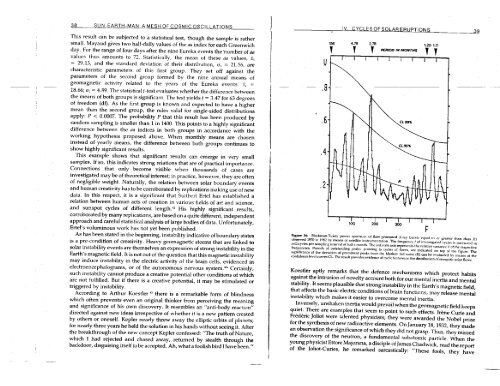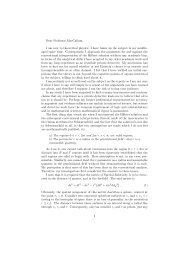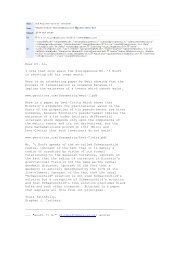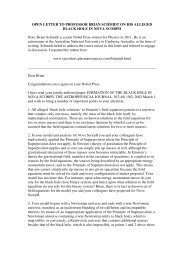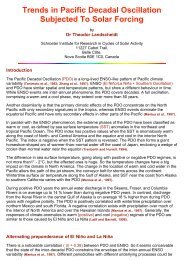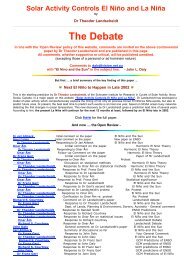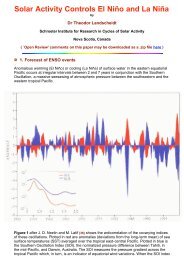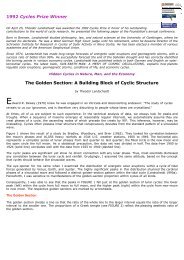Sun-Earth-Man - PlasmaResources
Sun-Earth-Man - PlasmaResources
Sun-Earth-Man - PlasmaResources
You also want an ePaper? Increase the reach of your titles
YUMPU automatically turns print PDFs into web optimized ePapers that Google loves.
38 SUN-EARTH-MAN: AMESH OFCOSMIC OSCILLATIONS<br />
This result can be subjected to a statistical test, though the sample is rather<br />
small. Mayaud gives two half-daily values of the aa index for each Greenwich<br />
day. For the range of four days after the nine Eureka events the humber of aa<br />
values thus amounts to 72. Statistically, the mean of these aa values, f,<br />
= 29.13, and the standard deviation of their distribution, u, = 21.56, are<br />
charactenstic parameters of this first group. They set oft against the<br />
parameters of the second group formed by the nine annual means of<br />
geomagnetic activity related to the years of the Eureka events: 2, =<br />
18.66; cr, = 4.89. The statistical t-test evaluates whether the difference between<br />
the means of both gmups is significant. The test yields f = 3.47 for 63 degrees<br />
of freedom (do. As the first group is known and expected to have a higher<br />
mean than the second group, the rules valid for single-sided distributions<br />
apply: P < 0.0007. The probability P that this result has been produced by<br />
random sampling is smaller than 1 in 1400. This points to a highly significant<br />
difference between the aa indices in both groups in accordance with the<br />
working hypothesis proposed above. When monthly means are chosen<br />
instead of yearly means, the difference between both groups continues to<br />
show highly significant results.<br />
This example shows that significant results can emerge in very small<br />
samples. If' so, this indicates strong relations that are of practical importance.<br />
connections that only become-visible when thousands of cases are<br />
investigated may be of theoretical interest; in practice, however, they are often<br />
of negligible weight. Naturally, the relation between solar boundary events<br />
and human creativity has to be corroborated by replications making use of new<br />
data. In this respect, it is a significant that Suitbert Ertel has established a<br />
reIation between human acts of creation in various fields of art and science,<br />
and sunspot cycles of different length.4z His highly significant results,<br />
corroborated by many replications, are based on a quite different, independent<br />
approach and careful statistical analysis of large bodies of data. Unfortunately,<br />
Gel's voluminous work has not yet been published.<br />
As has been stated in the beginning, instability indicative of boundary states<br />
is a pre-condition of creativity. Heavy geomagnetic storms that are linked to<br />
solar instability events are themselves an expression of strong instability in the<br />
<strong>Earth</strong>'s magnetic field. It is not out of the question that this magnetic instability<br />
may induce instability in the electric activity of the brain cells, evidenced in<br />
electroencephaIogams, or of the autonomous nervous sy~tem.~' Certainly,<br />
such instability cannot produce a creative potential other conditions of which<br />
are not fulfillid. But ifthere is a creativepotential, it may be stimulated or<br />
triggered by instability.<br />
According to Arthur Koestler there is a remarkable form of blindness<br />
which often prevents even an original thinker from perceiving the meaning<br />
and significance - of his own discovery. It resembles an "anti-body reaction"<br />
directed against new ideas irrespective of whether it is a new pattern created<br />
by others or oneself. Kepler nearly threw away the elliptic orbits of planets;<br />
for nearly three years he held the solutionin his hands without seeing it. After<br />
the breakthrough of the new concept Kepler confessed: "The truth of Nature,<br />
which 1 had rejected and chased away, returned by stealth through the<br />
backdoor, disguising itself to be accepted. Ah, what a foolish bird I have been."<br />
IV. CYCLESOFSOLAR ERUPTIONS 3 9<br />
156 4.76 2.78 120 1.11<br />
PERIOD INMONTHS<br />
7<br />
Fipm 16: Blackman-Tukey power spcrtrum of flar~-generated X-ray bursts equal tn or greater than class XI<br />
observed 1970 to I962 by means 06 satellltc mstrumentatim The fquel?cy f of inveshgatrd cycle4 is rneasurrd ~n<br />
rn~llicycles per sarnplingintelval of half a month. The urdlnate axis represcnls the relative vanance Vof thr respenive<br />
frequencies. Periods of outstanding peaks, painting to cycles of flares, are iodKated on top ol the figure. The<br />
signihrance of the deviation of prnmlnent peaks from the Markov red noise (R) can be ~valuatrd by means of the<br />
confidenrelevelcu*esCL. Thpresult pmv~drs evldenceof cyclic features in the distribution ofenergetic solarflares<br />
Koestlkr aptly remarks that the defence mechanisms which protect habits<br />
against the intrusion of novelty account both for our mental inertia and mental<br />
stability. It seems plausible that strong instability in the <strong>Earth</strong>'s magnetic field,<br />
that affects the basic electric conditions of brain functions, may release mental<br />
instability which makes it easier to overcome mental inertia.<br />
Inversely, unshaken inertia would prevail when the geomagnetic field keeps<br />
quiet. There are examples that seem to point to such effects. IrPne Curie and<br />
FredCric Joliot were talented physicists; they were awarded the Nobel prize<br />
for the synthesis of new radioactive elements. On January 18, 1932, they made<br />
an observation the significance of which they did not grasp. Thus, they missed<br />
the discovery of the neutron, a fundamental subatomic particle. When the<br />
young physicist Ettore Majorana, a disciple of James Chadwick, read the report<br />
of the Joliot-Curies, he remarked sarcastically: "These fools, they have


